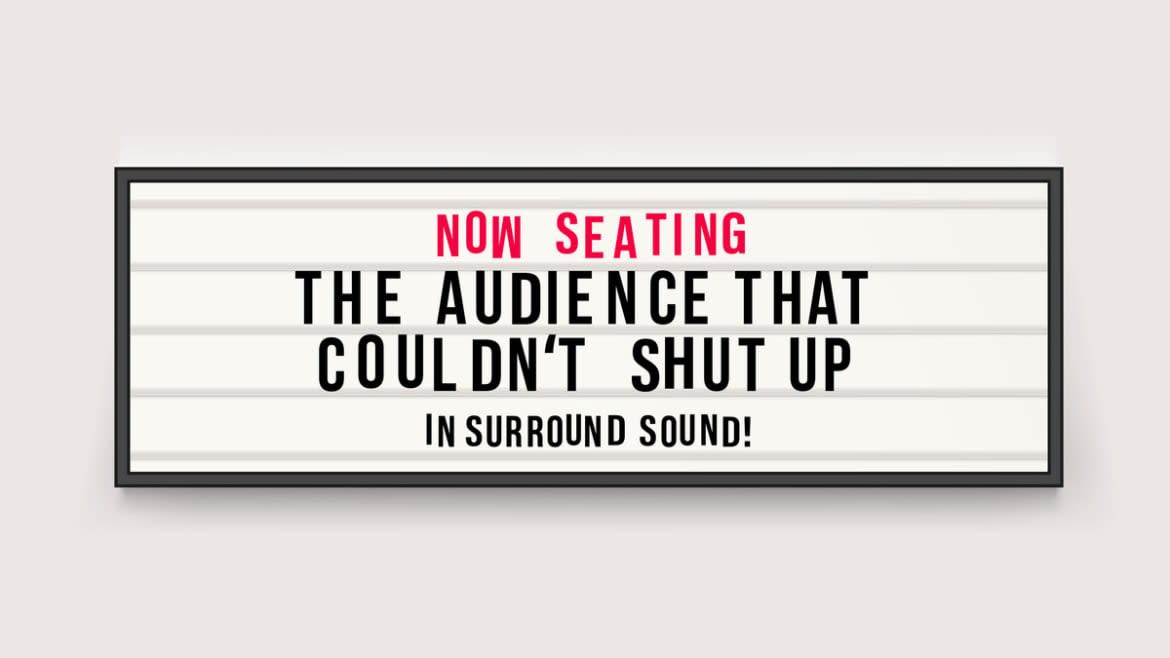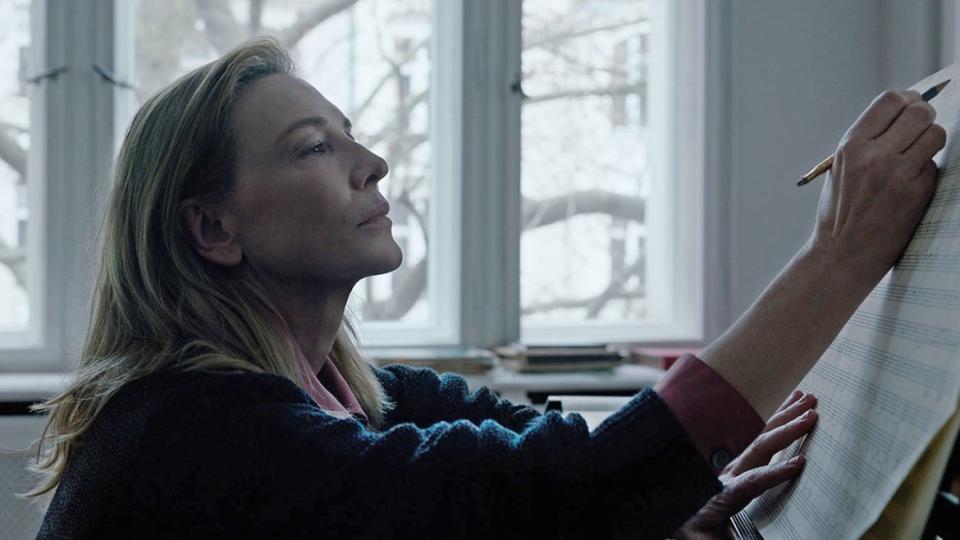Cate Blanchett Deserves Better Than Your Bad Movie Etiquette

Last Saturday, I did something that I promised myself I never would. It’s a transgression weighing heavily on my soul, a violation of every moral and social belief I’ve held since I became a freethinker (fresh out of the womb). Hell, some of my peers in the esteemed world of journalism would laugh me out of their circles! And if I am to be stripped of my ranks, so be it. But at my wit’s end, I was faced with no other choice: For the first time in my life, I walked out of a movie.
And not just any movie, either, but my favorite film of the year: TÁR. You know, the one where Cate Blanchett calls herself a “U-Haul lesbian” one second and then addresses how a subset of our society pigeonholes identity to politicize it into a faux personality the next. Or maybe you don’t already know, as TÁR is currently only in limited release, before expanding nationwide by Oct. 28. But doesn’t that sound like a movie during which you’d like to keep your focus on the screen and not on the dullards within a 50-foot radius? I certainly would’ve loved to, yet I was faced with an insurmountable challenge in that regard: Theater etiquette is in the gutter.
I have never, ever ever walked out of a theater. It was something that I couldn’t fathom. I’ve even silently questioned people when I’ve spotted them leaving in the middle of a movie. “What’s the point?” I thought. You paid for the movie, you’re already halfway through. Unless it’s an emergency, why not just stay? I was once hungover to what I would say was a nuclear degree and still managed to not only make it to but through both hours of Nightcrawler without even running to the bathroom, despite my beverage of choice that day being a water bottle the size of my head.
And yet, there I was in a Saturday matinee at Manhattan’s Angelika Film Center, scuttling out of the theater. It was not a statement of some haughty defiance, but rather the very rare activation of my fight or flight response. My body chose the latter, as I was not about to throw hands with the gaggle of older people who had filled the auditorium. That would be so inconsiderate—you can’t roll a bowling ball through a bunch of skeletons this close to Halloween!
I’m kidding. There were offenders of all ages present. Everyone came down from the greater tristate area to irritate me, which was strange because the official Annoy Coleman Day is actually Oct. 3, when corporations still think it’s funny to post that one Mean Girls meme on their brand accounts. But I digress!
This was to be my second time seeing TÁR, after I had seen it a couple of weeks prior at a press screening. (Hold your jeers, please, I can do nothing but my job.) After falling in love with it, I scrambled to get another ticket as soon as possible. I chose Angelika Film Center in lower Manhattan because it’s a chain that offers a curated selection for film lovers, and knowing how quiet most of TÁR is after seeing it once already, I was trying my best to impede any potential for a bad experience.
You’d think I’d know by now that, when you try to fight Murphy’s Law, it fights back harder.
In ‘Tár,’ Cate Blanchett Is at the Peak of Her Powers as a Formidable Maestro
Arriving at the theater with plenty of time to spare—the first priority of any self-respecting cinemagoer!—I sat down with a wave of excitement, my boyfriend next to me. His anticipation exceeded mine, after I had talked up TÁR for over a week. Finally, here we were, ready to let Cate Blanchett wave a baton in our faces and say a thousand words through only a few crumbled facial expressions, as only she can.
Moments later, like the grim reaper appearing from the shadows to call me to Hell, a group of three people appeared next to me in the aisle. I stood from my aisle seat and greeted my fellow movie lovers, letting them move to their seats comfortably. (Angelika still has old-fashioned, non-stadium seating.) Surely, they were here ready to experience the life-affirming nature of cinema alongside us. Or so I tried to convince myself, like someone who just realized they’re stuck in a very small elevator.
“Don’t worry, we’re only going to make you get up once,” one of the people in the group told me. Some people would take this as a comfort, an act of kindness to assuage me of the dread that had already begun to boil in my stomach. I saw it for what it really was: an omen.
Within half a second of them getting situated, they were up to shuffle out again. I’m no expert in math—why do you think I’ve made a career out of talking about the Kardashians at least once a week—but by my estimations, they had now made me get up twice. And there would be a third time when they returned with popcorn, a snack you simply don’t need at 3:15pm at a Todd Field-directed arthouse film.
Before the film’s opening credits even began, I was up and down a record four times. My boyfriend had to kindly signal that one of the group’s coats was entirely in his own lap. Full-volume talking followed every preview. But things only became worse once the extremely quiet opening credits rolled.
Running about four minutes and set to soft music that is being conducted by Lydia Tár, the film’s opening credits are essentially a plea for everyone in the theater to shut the hell up. That was not the case here, as multiple people stumbled in late and wondered aloud if they had somehow missed the film that they were already tardy for. “Is it over? These are the credits!” one woman asked no one in particular as she searched for her seat. Three people shushed her, and yet she continued until she sat down to find out for herself.
Though TÁR is about music, it is largely devoid of it. Many scenes are remarkably quiet. That meant we were all treated to an earful of the chuckle-monster having a goddamn field day in our row. TÁR can definitely be funny, but this guy clearly knew something the rest of us did not, because everything was given a low, hearty laugh. Cate Blanchett closing a door? Apparently, a laugh riot.
I could both see and feel everyone in my vicinity becoming visibly uncomfortable as these chuckles gave way to straight-up talking and phone use. And of course, the dreaded popcorn bag ruffling echoed throughout the theater like surround sound. Multiple people tried to give the casual over-the-shoulder glance—a universal signal for Please, Stop That!—but it did not take.
Unpacking the Shocking, Hilarious Ending of Cate Blanchett’s ‘TÁR’
What’s more, the BDFM train line rumbled below that specific theater every 10 minutes like clockwork, making a sound far worse than when you can hear an action movie playing in the theater next to a drama. An hour into TÁR’s nearly three-hour runtime, I became so anxious by the collective annoyance around me that I felt sick. My boyfriend whispered (as quietly as humanly possible!) to ask if I wanted to try to find an empty seat in the front of an already packed house, but it was too late. I motioned to him that I had to leave, grabbed my things, and dipped.
I knew he would understand; I had seen the film already and I just wanted him to have the experience he came for. After I left, he moved up to an empty seat in the third row and was mostly able to enjoy the remainder of the film, aside from some talking and phone screens appearing in his peripheral vision. But he told me after that the film was still sullied.
Is this all a little embarrassing in retrospect? Of course. I was being dramatic, and in hindsight, the image of me ducking as low as possible through the aisle so as not to ruin anyone else’s experience (more than the rumbling of the D Train below Angelika Film Center had already tarnished it) is extremely funny. But it’s a decision I stand by! I’m not alone in my suffering either; a quick search on Twitter suggests that I wasn’t the only person annoyed by the behavior of fellow moviegoers at their screening of TÁR.

Movies like TÁR demand your full attention. Without it, you’ll miss each meticulously crafted detail and the clever bits of irony that are embedded in the script at a cellular level. It doesn’t take an expert in film theory to dissect a movie like this, but it helps to be able to focus on all of the meaning in the margins to fully appreciate the astounding cinematic architecture in each frame of all 168 minutes.
And please, don’t get me wrong here. I know that the cinema is a place we all come to have fun, and I love fun—despite how some of this might read! I’m all for a designated rowdy screening and am even happy to concede that certain movies not only deserve but are made better by audience reactions. If I see Scream or Nope in a packed theater, I am expecting—dare I even say hoping!—for some verbal and physical reactions, like they used to have in the nightvision promos when a Paranormal Activity movie was released.
But TÁR, and other films like it, are not Paranormal Activity. They’re meant to be enjoyed in silence, with diligent respect to your fellow moviegoer. These experiences are different, just as all films are different, and each one deserves to be enjoyed with some compassion and consideration for those around us. I’m not sure if it’s the pandemic that has made theater etiquette get worse, or if it’s the public’s response to all of the nihilism in the air. But whatever it is, I’m practically begging the world to grow up. And if you feel attacked by an earnest appeal for general decency toward your fellow human, you should consider doing a little more soul searching before your next theatrical outing.
In the wise words of the brilliant Isabelle Huppert: “No snack, no drink, no food. Just being focused on movies. No noise!”
Get the Daily Beast's biggest scoops and scandals delivered right to your inbox. Sign up now.
Stay informed and gain unlimited access to the Daily Beast's unmatched reporting. Subscribe now.

